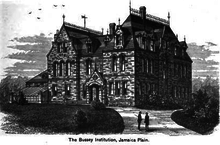Bussey Institution

The Bussey Institute (1883-1936) was a respected biological institute at Harvard University.[1] It was named for Benjamin Bussey, who, in 1835, endowed the establishment of an undergraduate school of agriculture and horticulture and donated land in Jamaica Plain, Massachusetts that became the Arnold Arboretum. Bussey, a silversmith, had bought the land from the Weld family in 1806, and built a mansion in 1815. When he died, he left 300 acres (1.2 km2) to Harvard, and by 1871 the Bussey Institute had been built.. James Drummond Dole obtained a bachelor in agriculture at the Bussey Institute before moving to Hawaii and developing pineapple growing and canning industry there.[2] Alfred Kinsey, an American biologist who became famous for his work on human sexuality, studied at the Bussey Institute under famed entomologist William Morton Wheeler.[3] Edward Murray East, a pioneer in plant genetics, also worked there when he studied Mendelian inheritance.[4] The geneticist William E. Castle worked there from 1908 until it closed in 1936, first on the genetics of fruit flies and also on hooded rats, studying basic evolution.
References
- ↑ Weir, John "Jack" A. (April 1994). "Harvard, Agriculture, and the Bussey Institution". Genetics. 136 (4): 1227–1231. PMC 1205903. PMID 8013900.
- ↑ C. F. Dole, My Eighty Years, E.F. Dutton Co., 1927, pp. 273-274.
- ↑ Gathorne-Hardy, J: Kinsey - Sex the Measure of All Things, Indiana University Press, 1998
- ↑ East, E. M. (1916). "Studies on size inheritance in Nicotiana". Genetics. 1 (2): 164–176. PMC 1193657. PMID 17245854.
External links